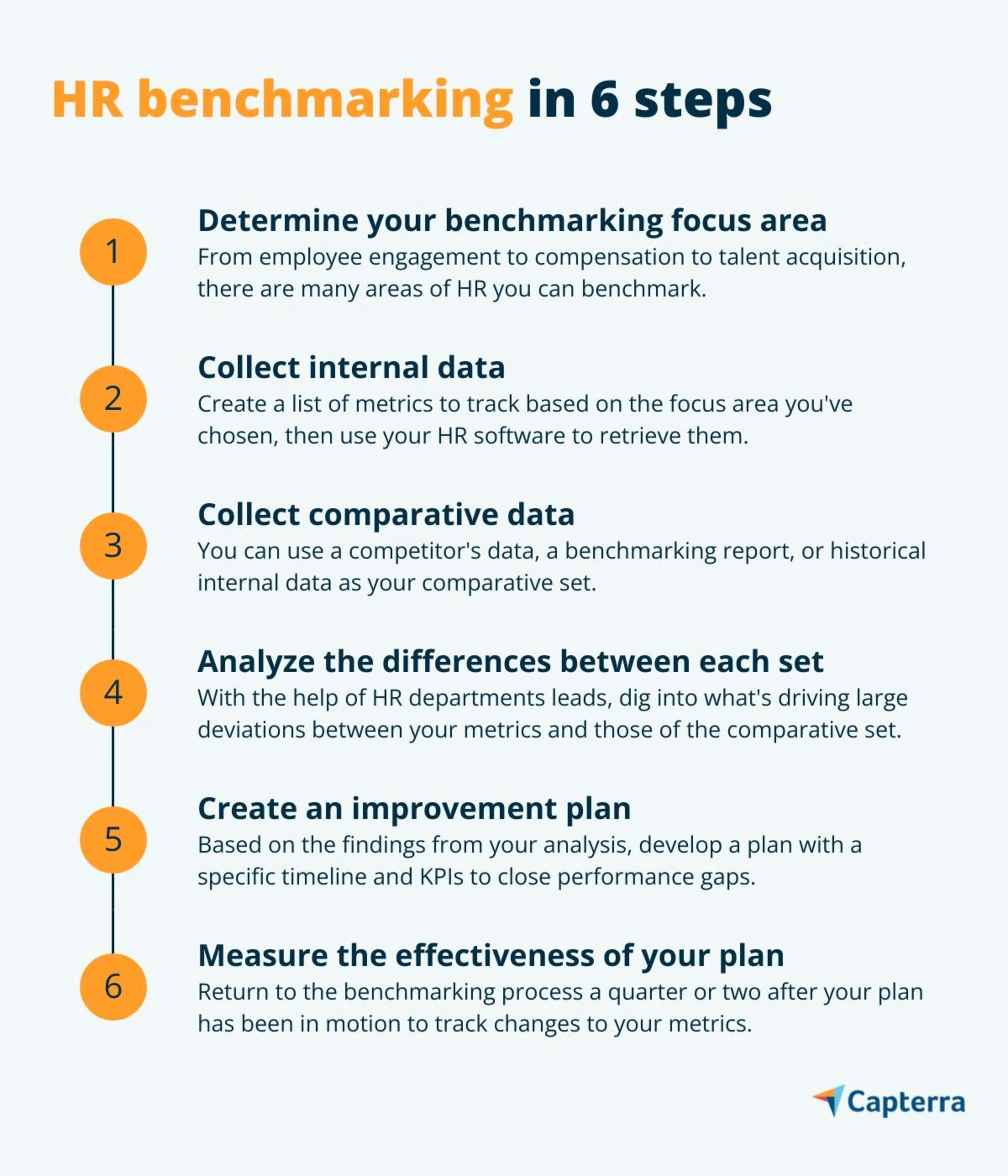Learn how HR pros can develop powerful improvement plans through benchmarking.
In 2022, it’s no secret that data is power. Today’s most successful HR leaders use data to inform every decision they make, from deciding who to hire and how much to pay them to what benefits and perks to offer (and so much more).
Having readily available data is great, but how do you amplify its value to make more informed decisions about the future of your workforce?
The secret lies in benchmarking, the practice of comparing your business’s performance metrics and processes to other companies’ and industry standards.
If you’re an HR professional who’s interested in keeping your business competitive, keep scrolling to learn more about this data-powered performance improvement strategy and how to implement it.
What is human resources benchmarking?
Human resources benchmarking is the process of comparing your organization’s key HR metrics to those from similar businesses. HR benchmarking can also entail comparing your present day metrics to results from years prior.
Why is HR benchmarking beneficial for businesses?
Reason #1: It helps pinpoint organizational problems
Benchmarking provides context that HR leaders need in order to suss out where their organization’s performance falls short. For example, if you compared your organization’s retention rate to a competitor’s or an industry benchmark and found that your rate was much lower, that signals there’s likely an organizational issue that’s spurring higher-than-average voluntary turnover.
Reason #2: ...and it also helps pinpoint where your organization is succeeding
On the other hand, benchmarking also makes it easier to identify where your organization outperforms your competitors. Continuing with the example above, you may find that your retention rate is actually much higher than the industry average. This is already a win, but then you could dive further into what within your HR strategy is contributing to that high retention rate so that you understand what makes your workplace a favorable one to employees.
Reason #3: Lastly, it improves data-driven decision making for HR teams
Ultimately, the motivation behind analyzing HR benchmarking data is to understand how you can move your business in the right direction. Whether you use an industry standard, a competitor’s HR metrics, or your own past performance as a frame of reference, the effect is still the same: more informed decision-making when it comes to your business’s HR strategy.
Ready to hire a recruiting agency for your business needs? Browse our list of companies in the following areas:
The HR benchmarking process in 6 steps

1. Determine what business area you'd like to focus benchmarking efforts on
Although you can benchmark just about any aspect of HR, it’s best to choose one area to focus your benchmarking efforts on. For example, you can benchmark everything from the composition of your workforce and your organizational structure to your HR department’s budget, but if you tried to do that all at once, it would be a challenge to come out of the benchmarking process with a clear vision of what to improve and how.
action item
To determine what the focus area of your benchmarking efforts should be, consult with senior management to get an idea of the business processes that have the most potential for improvement. Then, define the metrics you want to collect and compare.
If you need further help brainstorming which metrics you’d like to benchmark, don’t miss our related content: 8 HR Benchmarks You Should Be Tracking and How to Calculate Them.
2. Collect internal data
As mentioned in the step above, you should define the metrics you’re going to use as points of comparison in your benchmarking process. For example, if you’ve determined thatemployee engagement is going to be the focus of your benchmarking efforts, you’ll want to collect the following HR metrics for benchmarking:
Employee Net Promoter Score (eNPS): A method of measuring how willing your employees are to recommend their workplace to their family or friends.
Retention rate: The number of employees who stay at your company for a certain period of time compared to the total number of employees in that period.
Internal promotion rate: The measurement at which opened positions in your organization are filled by internal hires.
Voluntary employee turnover rate: The rate at which employees willingly leave your company within a given period.
action item
Using your list of predefined metrics as a guide, start collecting data. Most HR software tools have a reporting functionality you can use to access data about your workforce and business. In fact, some tools will even allow you to build a custom report with only the information you need for evaluation (like in the example below). If you don’t have HR software, though, you can manually calculate most HR metrics and all the formulas you need should be just a quick web search away.
If you plan to regularly benchmark as a business performance improvement strategy, it may be worth it to invest in HR analytics software. HR analytics tools not only provide you with data and insights about your workforce, they also help you design and implement HR initiatives that will benefit the future of your business.
3. Collect external or historical data for comparison
Now for one of the most challenging parts of the benchmarking process: collecting external benchmarking data—or alternatively, internal data from years prior.
If you’re planning on using external data from other companies: Make sure that you’re looking at businesses in the same industry, of a similar size, and if possible, in the same geographic region. Also know that acquiring a competitors’ data is no easy task; Most workforce information is considered confidential, so if you’re going down this route, you have limited options.
One option is to use publicly accessible data such as benefits and compensation information on job postings and employer review websites (such as Glassdoor), but with this strategy you run the risk of using old or inaccurate data. If you have contacts at similar businesses, a better approach would be to set up interviews or send out a formal questionnaire to get the information you need, but make sure you’re forthcoming about the motivation behind your research.
If you’re planning on using historical internal data for comparison, you can use your HR software system to access information from years prior. If you haven’t been collecting information over the years, consider adopting a data management system of some sort, whether it’s a human resources management system (HRMS) or another tool.
Ultimately, the best way to get reliable benchmarking data is to shell out for an industry benchmark report from a reputable research institution.
For instance, Gartner has multiple reports from the last year available to clients:
action item
Decide whether you’re going to benchmark against external data from competitors, a benchmarking report, or your own organization’s data from years prior. You may have to make this decision based on how easy it is to get ahold of each kind of data. Once decided, start collecting the metrics you need in a report or spreadsheet.
4. Analyze the differences between your metrics and the comparative data
Once you have all of the data needed to benchmark (both your organization’s and the external or historical information) it’s time to compare the metrics. To do this, build a spreadsheet or report with the two sets of metrics side-by-side, then identify where the data aligns as well as where there are significant deviations.
Deviations between your data and the comparative data should not be taken as “good” or “bad” at face value. In fact, deviations should be expected, as every business is different in how it operates—the bigger the discrepancy, though, the greater the need for further analysis.
action item
Gather the leaders of your HR department (such as the HR manager and recruiting director) to analyze the benchmarking data. Focus your analysis on metrics with major gaps between them, and try to dig into the processes and practices that contribute to those deviations. The goal of this analysis is to determine which performance gaps are worth trying to close in the future.
For example, if your cost-per-hire is much higher than that of the comparative data, it could be because you’re recruiting in a competitive location where it takes more time and money to fill a role. But that’s not necessarily a lost cause: You could expand your recruiting pool to include remote workers in other geographic locations, hopefully helping to bring more qualified candidates into the process earlier on.
5. Create a plan for improvement based on your analysis
Your analysis of the benchmarking data should bring to light which areas of your people strategy can be improved. Next, it’s time to put pen to paper and brainstorm how you can do that. The plan you create should directly address what you believe to be the drivers behind performance gaps.
For instance, if your eNPS is poor when put side-by-side with the comparative data, the first step of your plan of action should be to collect feedback on the employee experience at your organization from your workers.
action item
Make a business case for rolling out a performance improvement plan by preparing a report that showcases the most concerning performance gaps that were revealed through the benchmarking process. Develop a plan of action with a clearly defined timeline and key performance indicators with the help and support of your organization’s executive leaders.
6. Measure the effectiveness of your plan
Of course, any time you kick off an improvement plan, you have to measure the results in order to accurately judge whether it was successful or not. Fortunately, you already know which metrics you should be tuned into, because they’re the same ones that inspired the focus on your improvement plan.
action item
Based on the timeline you created for your improvement plan, repeat the benchmarking process and track how your metrics changed. Share the results with executive leaders, and make any adjustments necessary to further your progress.
Capterra Tools & Tips
If you plan on making benchmarking a regular part of your business performance improvement strategy, make sure you bookmark the resources below.
3 HR Benchmarking Examples From a Real HR Pro: Get an inside glimpse at benchmarking in practice from a real HR professional.
The 2022 Capterra Shortlist for Human Resources Software: Having the right HR software tool means less time crunching numbers and more time making sense of them. Start your search with a list of over 20+ top-rated HR software systems.
Invest in a platform that prioritizes continuous improvement
Currently, we’re in the midst of a widespread talent shortage that’s prompted over 75% of CEOs to change their talent strategy to address the key causes of talent risk (full content available to Gartner clients).
As an HR leader, you’re responsible for supporting today’s workforce and planning for tomorrow’s. Don’t let your organization fall behind by failing to take action. Adopting a regular benchmarking process will help you make more informed decisions about your talent strategy. And luckily, today’s wide range of HR software tools are here to help lighten the load. And even better:Many of them are free.
Whether you need a data management solution that will store and make sense of employee data, or you’re looking for an advanced HR analytics platform that will turn insights into improvement plans, there’s a tool out there that will fit your needs and budget.
Note: The applications selected in this article are examples to show a feature in context and are not intended as endorsements or recommendations. They have been obtained from sources believed to be reliable at the time of publication.


